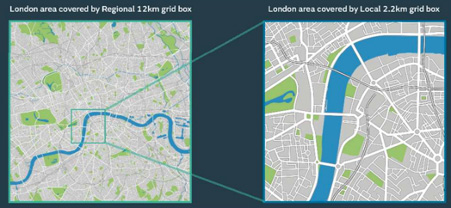Guest post: How ‘high-resolution’ climate models will help Europe plan for extreme weather

“Convective” storms cause some of Earth’s most dramatic weather, including extreme rainfall, hail, lightning and severe wind gusts. Along with lighting up the skies, these storms frequently cause catastrophic damage. In Europe, for example, the costs run to billions of euros every year.
Scientists expect that the frequency and intensity of convective storms will change as the climate warms. And understanding these changes is crucial to ensuring the resilience of critical infrastructure to extreme weather.
However, accurate projections of convective weather require “high-resolution” climate models. Yet climate services often lack such detailed data and are typically built on the coarse climate model output available.
As a result, adaptation planning – regarding, for example, urban flood management, hail damage to solar panels and crops, and lightning impact on electricity networks – are often left to crude assumptions.
Fortunately, a new generation of climate models – known as “convection-permitting models” (CPMs) – are providing a step change in our ability to project changes in high-impact weather extremes.
In a pair of new papers, published in Climate Dynamics, we show how recent advances in the use of CPMs are bringing about a step change in the information available for climate change risk assessment in Europe.
High resolution models
In order to simulate the Earth’s climate, a model divides up the Earth’s surface and overlying atmosphere into a giant grid. The model then calculates climate variables, such as temperature, humidity and rainfall, for each grid cell.
Global models typically have grid spacings of the order of 10-100km. Modellers have to find a balance between the added detail of smaller grid cells with the greater computing power that higher resolution models require to run.
“Convection-permitting models” (CPMs) are very high-resolution models of the Earth’s climate that have a grid spacing of less than 5km. CPMs better represent small-scale processes in the atmosphere. As the name suggests, this includes convection – a key process in many damaging extreme weather events. (You can read more about convection and CPMs in Dr Lizzie Kendon’s earlier Carbon Brief guest post.)
This improved level of detail is illustrated in the maps below. They show the region of London covered by a 12km grid box that represents a typical regional climate model (left), compared to a 2.2km grid box as used in CPMs (right).

CPMs are widely used in weather forecasting, but increases in supercomputing power mean they are increasingly becoming affordable for long-term climate projections, such as the UK climate projections (UKCP) and the European Climate Prediction system (EUCP) projects.
UKCP and EUCP provide high-resolution climate simulations, for the UK and Europe respectively, for the coming decades that can be used for risk-based planning.
For example, flash floods – primarily caused by intense rainfall on sub-daily timescales – are likely to become more frequent across Europe in future. Cities have a particularly high vulnerability, with the risks of urban flooding and the number of people exposed expected to increase.
CPMs provide – for the first-time – robust projections of future changes in short-duration precipitation extremes. Our research shows that summertime hourly rainfall is intensifying more than previously thought and has shown significant changes in the frequency of exceeding key flood alert thresholds.
CPMs also indicate traditional climate models may underestimate average rainfall changes in winter, where wintertime convective showers are a key contributor.
With their more detailed process representation, CPMs are successful in closely mimicking key physical processes of severe convective storms. These include resolving the air currents within storms – known as updrafts and downdrafts – and better representations of hail, soft hail (“graupel”) and lightning.
Accurate simulation of ice-based processes is important for correctly simulating electrical charges within storms. For example, recent studies suggest that including these processes can result in future lightning change projections of the opposite sign to that found in earlier work.
CPMs are also providing new information on future changes in wind extremes and “sting-jets”. Sting jets are cores of very high wind speeds found in some cyclones and require high-resolution models in order to be adequately represented. They are responsible for some of the most damaging surface wind gusts, such as the UK’s Great Storm of 1987.
Understanding uncertainty around CPM projections
Much of what we have learned from CPM projections to date has been based on simulations from one CPM for a given region. But, by running several different CPMs for the same region – each developed by a different climate modelling centre – we can test how robust our results are and learn more about the uncertainty in future high-impact weather.
*This guest post is by:
Prof Lizzie Kendon, a science fellow at the UK Met Office and professor at Bristol University
Dr Emanuela Pichelli, a researcher at the Abdus Salam International Centre for Theoretical Physics
Dr Nikolina Ban, an assistant professor at the University of Innsbruck
Marjanne Zander, a PhD candidate at Wageningen University and Research
Dr Carol McSweeney, a climate scientist at the UK Met Office
Dr Alexander Askew, a climate-science communicator in knowledge integration team at the UK Met Office
12 April 2021
Carbon Brief




